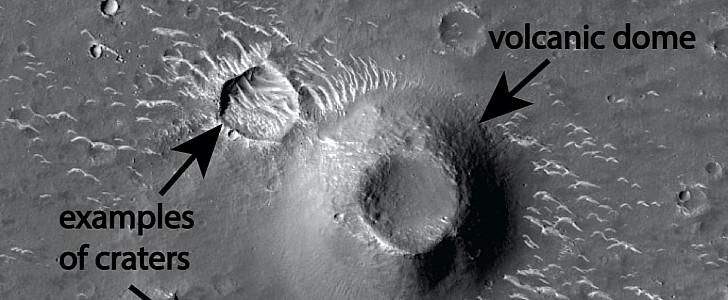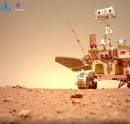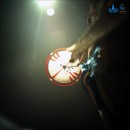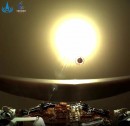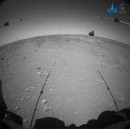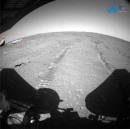Pareidolia. This is the official term used to describe, in a narrow sense, the human inclination to see familiar images and patterns where there are none. It’s also what’s responsible for some of us seeing Mickey Mouse in this image from Mars.
Being such a strange place, Mars has always fascinated us humans. Now that there are a number of technologies out there on and around the planet, studying and surveying it, our senses are flooded with stimulus for the imagination.
Whereas the rovers down on the surface get the most media exposure thanks to their hands-on approach to things, it is the Mars Reconnaissance Orbiter (MRO) circling the planet that gives us the greatest views. Like the one we have here.
The image shows a portion of the Utopia Planitia volcanic region of Mars. We get, as usual, a considerable amount of impact craters, but also a large volcanic dome. It is that volcanic dome, and the two larger craters at its north that for some form the distorted picture of Mickey Mouse, with no eyes, no mouth, but with a very large nose.
This is, of course, just an impression, not the work of some Martian with a passion for the Disney character. Everything you see in the pic (click main photo to enlarge) is as natural as they come, a glimpse of a portion of Mars currently being surveyed by the only non-American rover to reach Mars, the Chinese Zhurong. Aside from the Zhurong, the area is also the resting place for the 1970s Viking 2 lander.
Planitia is part of the so-called Utopia impact basin, the largest on Mars, measuring a diameter of 3,300 km (2,050 miles). It’s believed to presently hold an impressive amount of underground ice, with an estimated water content the size of Lake Superior here on Earth, the world’s largest lake by surface area and the third-largest by volume.
So, let’s keep a close watch on this place, as one never knows when Mickey Mouse starts shedding some tears through its invisible eyes.
Whereas the rovers down on the surface get the most media exposure thanks to their hands-on approach to things, it is the Mars Reconnaissance Orbiter (MRO) circling the planet that gives us the greatest views. Like the one we have here.
The image shows a portion of the Utopia Planitia volcanic region of Mars. We get, as usual, a considerable amount of impact craters, but also a large volcanic dome. It is that volcanic dome, and the two larger craters at its north that for some form the distorted picture of Mickey Mouse, with no eyes, no mouth, but with a very large nose.
This is, of course, just an impression, not the work of some Martian with a passion for the Disney character. Everything you see in the pic (click main photo to enlarge) is as natural as they come, a glimpse of a portion of Mars currently being surveyed by the only non-American rover to reach Mars, the Chinese Zhurong. Aside from the Zhurong, the area is also the resting place for the 1970s Viking 2 lander.
Planitia is part of the so-called Utopia impact basin, the largest on Mars, measuring a diameter of 3,300 km (2,050 miles). It’s believed to presently hold an impressive amount of underground ice, with an estimated water content the size of Lake Superior here on Earth, the world’s largest lake by surface area and the third-largest by volume.
So, let’s keep a close watch on this place, as one never knows when Mickey Mouse starts shedding some tears through its invisible eyes.
